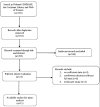Prognostic role of platelet-lymphocyte ratio in colorectal cancer: A systematic review and meta-analysis
- PMID: 27310960
- PMCID: PMC4998446
- DOI: 10.1097/MD.0000000000003837
Prognostic role of platelet-lymphocyte ratio in colorectal cancer: A systematic review and meta-analysis
Erratum in
-
Erratum: Medicine, Volume 95, Issue 24: Erratum.Medicine (Baltimore). 2016 Aug 7;95(31):e5074. doi: 10.1097/01.md.0000490009.39850.74. eCollection 2016 Aug. Medicine (Baltimore). 2016. PMID: 31265618 Free PMC article.
Abstract
Many studies have been reported that platelet-lymphocyte ratio (PLR) may be associated with the prognosis of colorectal cancer (CRC), but the results are inconsistent. Current opinion on the prognostic role of the PLR in CRC is inconsistent and inconclusive. Therefore, we conduct a meta-analysis that combines these studies and to identify the prognostic value of PLR in patients with CRC. Data were retrieved from PubMed, EMBASE, Cochrane Library, and Web of Science databases that came from inception through January 2016. We extracted data from the characteristics of each study and analyzed the relationship between PLR and overall survival (OS), disease-free survival (DFS), or other prognosis in patients with CRC by using the hazard ratio (HR) and 95% confidence intervals (95% CIs). Of the 256 identified studies, 15 studies were included and a total of 3991 patients were included. In a meta-analysis, patients with an elevated PLR had a significantly lower OS (pooled HR, 1.53; 95% CI, 1.24-1.89; P ≤ 0.001), DFS (pooled HR, 1.68; 95% CI, 1.07-2.62; P = 0.023). Even after sensitivity analyses and trim and fill method, high PLR remains significantly predictive poorer OS, but not DFS. In addition, our meta-analysis indicated that increased PLR is also significantly associated with the poor tumor differentiation [odds ratio (OR) 2.12; 95% CI, 1.45-3.08, P < 0.001)], the propensity toward depth of infiltration (OR 1.69; 95% CI, 1.20-2.39, P = 0.003), and recurrence in patients with CRC (HR, 2.71; 95% CI, 1.31-5.60, P = 0.005). This meta-analysis suggested that a high peripheral blood PLR can be used as a predictor of OS connected with clinicopathological parameters in patients with CRC, not DFS. These ratios may thus contribute to inform more personalized treatment decisions and predict treatment outcomes.
Conflict of interest statement
The authors report no conflicts of interest.
Figures





References
-
- Siegel RL, Miller KD, Jemal A. Cancer statistics, 2016. CA Cancer J Clin 2016;66:7–30. - PubMed
-
- O’Connell JB, Maggard MA, Ko CY. Colon cancer survival rates with the new American Joint Committee on Cancer sixth edition staging. J Natl Cancer Inst 2004;96:1420–5. - PubMed
-
- Oliphant R, Nicholson GA, Horgan PG, et al. Deprivation and colorectal cancer surgery: longer-term survival inequalities are due to differential postoperative mortality between socioeconomic groups. Ann Surg Oncol 2013;20:2132–9. - PubMed
Publication types
MeSH terms
LinkOut - more resources
Full Text Sources
Other Literature Sources
Medical

